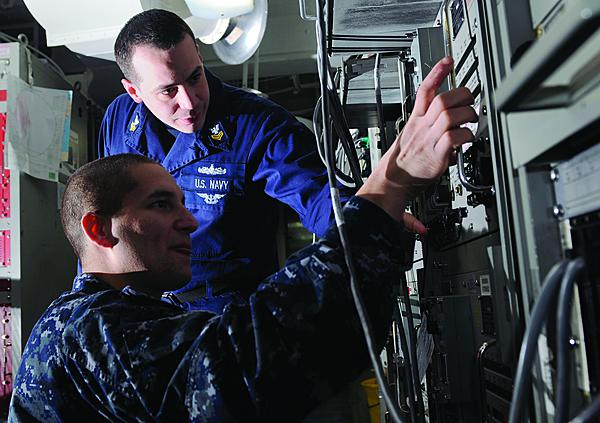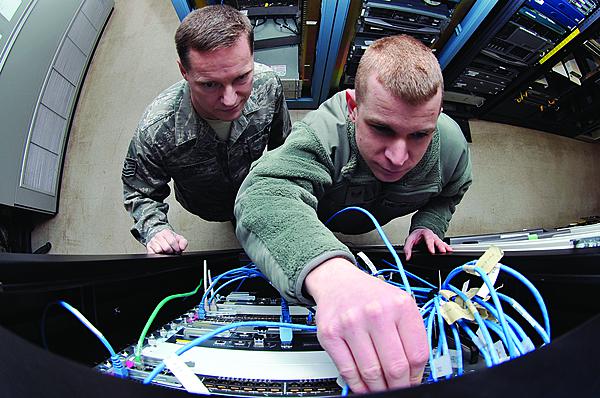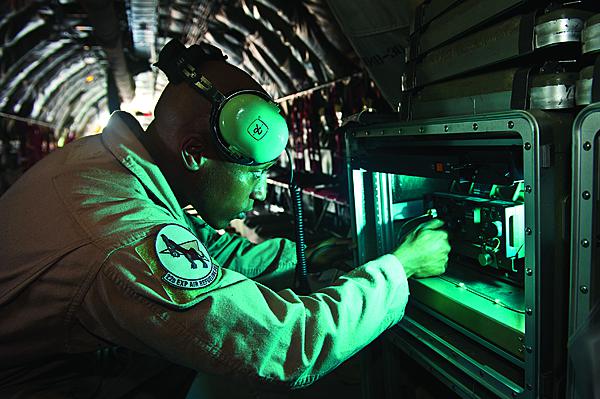Not Your Father's J-6
The newly reconstituted Joint Staff office is not just picking up where the previous version left off.
 |
| A U.S. Navy information systems technician troubleshoots network equipment onboard the USS Carl Vinson. Future U.S. military platforms may be designed with space designated for communications equipment, which would be incorporated after the platform rolls off the assembly line. |
After a two-year organizational hiatus, the Joint Staff J-6 billet is back with a new focus on interoperability and enterprisewide networking capabilities. These new authorities come as the military seeks to exploit commercial mobile communications technologies to an increasing degree with results that could change the nature of defense networking as well as its procurement.
All of the issues that have defined defense information technology utilization—interoperability, security, rapid technology insertion—are part of the thrusts being launched by the new J-6. Even the very nature of requirements may change as industry adopts the new approaches being endorsed by the Joint Staff’s new information office.
“This is not the same J-6 that existed before,” declares Maj. Gen. Mark S. Bowman, USA, director of command, control, communications and computers (C4), J-6, and chief information officer (CIO), the Joint Staff. “It is very different.”
Foremost among the differences is that the new J-6 now is also the Joint Staff CIO, which brings new responsibilities along with an inward focus. This focus is appropriate, the general states, explaining, “We ought to be able to execute what we think ought to be executed elsewhere.” This allows the new J-6 office to take innovations and new directions that it has adopted and push them throughout the military.
The new J-6 also has the C4 interoperability responsibilities that came from the disestablished Joint Forces Command (SIGNAL Magazine, July, page 59). Elements of that command’s J-8 were transferred to the Deputy Director for C4 (DDC4) office, which was responsible for C4 integration and assessments. The DDC4 office has been incorporated into the new J-6. Gen. Bowman notes that 70 people from the 170 in the former J-6 were assigned to the DDC4. Those and the people from the other absorbed organizations totaled 1,100 people in the new J-6. Reductions have brought that number down to a little more 800. When the original J-6 was eliminated, its missions were parsed to other organizations. Those missions have been reclaimed, Gen. Bowman says, but the personnel slots were not added to the new J-6. The J-6 has met its responsibilities by tapping its existing human resources.
The J-6 established a new directorate—Information Technology Transformation, or ITT. This directorate focuses on the way ahead, Gen. Bowman says. “They are looking at what we are doing with the portal, and when we are going to have thin client across the Joint Staff,” he says as examples. Gen. Bowman relates that the Defense Department CIO establishes policy; the Joint Staff J-6/CIO generates requirements and engages in facilitation; and the services execute. “If we stay in those lanes—and mutually assist each other with those lanes—we can get to where we need to go,” he warrants. “We have had no problem staying in those lanes.”
Interoperability is the general’s top priority, both across the services and among coalition partners. At the heart of this effort is the Joint Information Enterprise (JIE) program, which the general offers is making significant strides. “It’s not something that’s nice to have; it’s something we must have,” he declares. “We have to have interoperability baked in from the beginning in what we do.”
The general continues that one perfect example of an enterprise solution is enterprise email. Not all users need to run their own email systems, he says. The Joint Staff switched to enterprise email for nonsecure Internet protocol router network (NIPRNET) operations a few months ago by beginning with a pilot effort in the J-6 and then spreading it across the entire Joint Staff. The Defense Information Systems Agency (DISA) provided this service. By the end of this year, the J-6 will have secret Internet protocol router network (SIPRNET) enterprise email.
 |
| Two Air Force cyber transport technicians hook cables in to the new Air Force Network (AFNet) router at Eielson Air Force Base, Alaska. The AFNet system recently came online at Eielson and has enhanced cyber capabilities by providing network oversight to all Air Force installations. |
This activity was enabled in conjunction with thin client, and the Joint Staff wants to push thin client “in a big way,” the general offers. The primary reason for that emphasis is security. The thin-client approach in an enterprise environment allows rapid application of patches—in minutes or even seconds—or changing of operating systems over only a weekend. The J-6 has several ongoing thin-client activities underway, and about 2,000 accounts will be using it by the end of the year. “My goal is to be completely moved over to thin client on SIPRNET and NIPRNET before I leave the Joint Staff,” Gen. Bowman declares.
This enterprise effort will see an increased emphasis on commercial off-the-shelf (COTS) equipment “that is interoperable from the get-go,” Gen. Bowman declares. “We have to be willing to accept 80 percent solutions today, implement them today, and then gradually evolve them over time—and we will end up with capabilities that we never dreamed of in the past.”
The general analogizes this effort to the technological march that has taken place in recent years. Five years ago, no one would have guessed how smartphones would be used today—“not even Steve Jobs,” he points out. “He wouldn’t have predicted that we’d use an iPhone to check in at the airport; as a GPS [Global Positioning System] in our cars; or for so many other things, when he unveiled it over five years ago.”
Another key thrust for the J-6 is to enable Joint Force 2020. Gen. Bowman notes that what the J-6 can influence in the program objective memorandum carries out to 2020. “Much of what we will have for capabilities in 2020 already is decided. Some people have estimated that we already have 80 percent of the capabilities that we will have in 2020. IT [information technology] lies in that other 20 percent. There is huge room for change in IT between now and 2020. Huge advantages will be made between now and 2020,” he states.
The J-6 has other enterprise projects in the works. Among these is data center consolidation, which the general describes as a huge effort. He says the Marine Corps data center is likely to stay, but other data centers are being considered for consolidation to reduce the number of facilities in use. Moving to the cloud is another key activity, and it is spurring other potential changes. “My view is that, anything that is a public-facing Web page, we ought to seriously look at putting in a commercial environment,” the general offers. “We’re looking at the right way to do that and the right stuff to put in there.” He adds that his office will continue to meet with industry to explore these types of opportunities.
Gen. Bowman emphasizes that the military’s end-state architecture is everything over IP (EoIP). “If people say that we can’t put everything over IP, then OK—make it almost everything over IP. It’s the wave of the future, and we need to embrace that—not fight it, embrace it.”
Achieving necessary interoperability will entail building on past successes, the general maintains. For coalition interoperability, the Future Mission Network is evolving from the Afghan Mission Network, and the J-6 is striving to establish a set of tactics, techniques and procedures (TTPs) that could be used by coalition partners. The goal is a network that would be able to operate from the onset of deployment, whether disaster relief or combat operation.
Yet issues remain. One is encryption; and the general offers that different degrees of encryption may provide the best security for the fully interoperable coalition network. Significant moves have opened the door to establishing network security where not everything is given Type 1 encryption. For example, the general offers, commercial encryption may be good enough for perishable data. “If I get a call for fire or a troops-in-contact report, why would commercial encryption not be good enough there?” he asks. “It’s all perishable data. If the bad guy is able to decrypt it in two weeks and figure out what the request was, that mission is long over [by then]. Whereas, the true benefit of commercial encryption is that we can give a radio to one of our coalition partners going out on a mission ... and we can coordinate intelligence as we go through an operation with a coalition partner. If we receive intelligence that changes the situation on a battlefield, we can get that information to partners so that they can change the way they are going to approach their particular mission.”
 |
| A U.S. Air Force airman adjusts the frequency of the Roll-On Beyond Line of Sight Enhancement (ROBE) datalink system in Kyrgyzstan. ROBE connects manpower assets on the ground, which may not have effective line-of-sight communications capabilities, to other ground or airborne units. The new Joint Staff J-6 is pushing for enterpise efforts to ensure service and coalition interoperability. |
Because the United States spends more on defense than other nations, it tends to set standards for military information technology systems. That standard-setting must be done carefully, the general warns. “If we decide a standard, and coalition partners procure equipment [accordingly] to be interoperable—and then we decide to change the standard tomorrow—that causes us not to be interoperable and [a partner country] to have to play catch-up with a much smaller budget and a much longer reaction time,” he allows.
Gen. Bowman offers that service interoperability is not a prerequisite for coalition interoperability. “I think they can come simultaneously,” he says. “Much of what we do IT-wise today is commercial off-the-shelf related. With the proper set of TTPs and agreed-upon way ahead by services, we can get to interoperability simultaneously. We really don’t have a choice.”
The general explains that the military does not have the luxury of proceeding service-by-service in a buildup to coalition interoperability. “We need set architectures out there; and when people build to those architectures, their wares get included. If they don’t meet those architectures, their wares do not get included. And, we’re being driven to those architectures today by commercial off-the-shelf equipment,” he states. “If we try to develop our own equipment in big programs of record, it takes time. Others are able to develop those things, and there are game-changing devices out there today that we ought to be looking at hard and adapting.”
The general notes that senior commanders across the services face challenges of establishing operational priorities for using valuable bandwidth. These types of trade-offs will continue as commanders on the ground weigh priorities for communications and bandwidth, especially as changes continue to define the network.
Gen. Bowman allows that he works closely with his equivalents in the individual services. “I spend more time with the service -6s than I do with the combatant command -6s,” he states. That may change in the future. The bulk of the J-6’s recent effort has involved the JIE and CIO matters, and Gen. Bowman offers that he has not spent enough time with the combatant command -6s as he believes he should have. While they do share information, he wants to build a closer relationship with them than he has today.
Technology and culture are at the heart of the J-6’s efforts to implement long-term changes on the force. Part of the cultural challenge is the belief that the U.S. military conducts information technology implementation better than anyone else. Yet, the validity of that statement hamstrings efforts to improve. Gen. Bowman notes that many new technologies available today—such as “one box, one wire”—could save billions of dollars if they were adopted. The Defense Department does not have any exact figures for the amount it spends on information technology across the board, because different vehicles and organizations are used for its acquisition. Again, moving to an enterprise environment can help the department understand how much it spends on information technology as well as gain control of the acquisition process, particularly with regard to interoperability and priorities. “It ought to be vendor-agnostic and focused totally on the requirements and the architecture,” he says of information technology acquisition.
Letting go of control may be necessary to win many of the cultural battles, the general continues. For example, instead of focusing on running information technology, organizations should focus on their core competencies and let others provide information technology as a service. Even as DISA provides the J-6 its email, the J-6 runs the help desk. Gen. Bowman states that his organization does not need to run its own help desk, and instead it should move that help desk to another organization accustomed to operating a help desk to provide a net savings for the department. Others can follow suit.
Mobile technologies currently are the hot items for military information technology. Gen. Bowman states that the force needs mobile devices that are secure enough for operation. Ongoing pilot programs with iPads, iPhones, Droids and other tablets are part of the move toward a more mobile environment. Common Access Card (CAC) enabling is a requirement, he stresses. “We’re going to use the hard token for security reasons as opposed to user identification and password,” he warrants. “We are going to line ourselves up by what needs to be done to achieve the appropriate level of security, and we’re not going to waver from that.
“We will take the appropriate level of risk, but we need to truly understand what we’re getting—and there will be some requirements that we’re not going to back off of,” he continues. “When we say an 80 percent solution, in that 80 percent will be the requirements we will not back off of.” Interoperability and nonproprietary solutions—open systems built to standard—are two other 80 percent requirements, he adds.
“There has never been a greater dependence on the network than there is today; there has never been a more significant cyberthreat than there is today; and it will only get worse in the future—and, we’re faced with fiscal realities where we’re going to have smaller budgets in the future,” Gen. Bowman points out. “We’re going to get driven to interoperability, and we’re going to get driven to enterprise solutions.”
Great changes are coming by the end of this decade, the general predicts. He points out that by 2020, digital natives will be in leadership positions in the U.S. military. Their understanding of digital systems and capabilities will be proactive rather than reactive. The tactical operations center (TOC) of the future will be very different from today’s version. Wireless connectivity will define the TOC, as warfighters will be able to pull down information into a handheld device. Handheld capabilities will increase in number and grow in sophistication, all amid greater interoperability.
The evolution that will define future military information technology also will change the very definition of requirements. Gen. Bowman believes that, when a service buys a platform, it should dedicate a certain amount of space in that platform for communications equipment. That space would include internal duct work for cabling, sufficient power and adequate cooling. Then, the platform would be ready for its communications when it rolls off the assembly line—which is the time when the communications should be purchased, not before.
“Honesty and openness” are the two most important elements that Gen. Bowman says he needs from industry. “When they say they have a product that meets certain standards, it needs to meet it. [It should not be] a black box with some knobs on the outside and no guts on the inside—a concept they are looking for us to embrace and then pay for the R&D [research and development] on. They are making enough money so that their R&D dollars ought to be focused on what they think they need to build to meet the needs of the customer,” he declares. “And, the customer isn’t only the Defense Department—it’s the world.
“We saw what happened over the past five and a half years,” the general says. “I cannot predict [what will happen in] 2020. But I know we will have to get there incrementally, or we are going to be irrelevant.
“Our adversaries are using COTS technology,” he continues. “We need to stay ahead of them and use COTS technology and understand it and understand its limitations—and we need to make sure we’re lockstep with the Cyber Command and NSA [National Security Agency] as well.”
The biggest enemy the military faces with effective information technology use is delay, Gen. Bowman declares. “If we do nothing, that’s the worst thing that could happen,” he warrants. “If we are OK with what we have today, we are going to be irrelevant.”



Comments